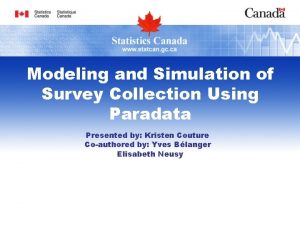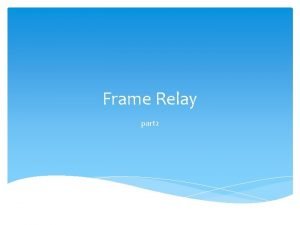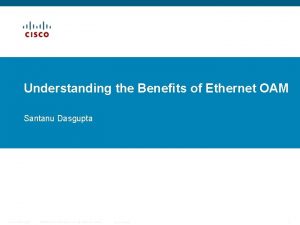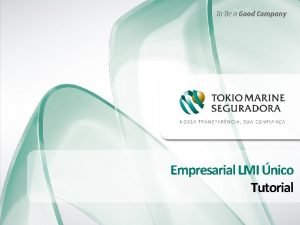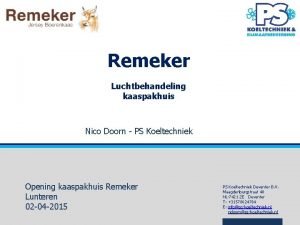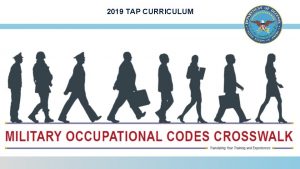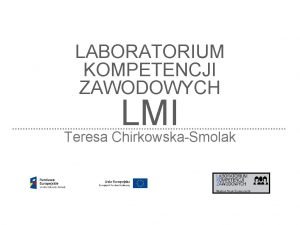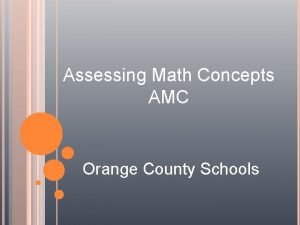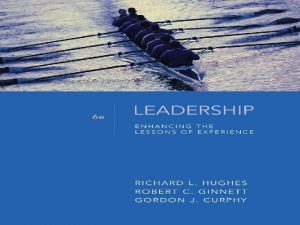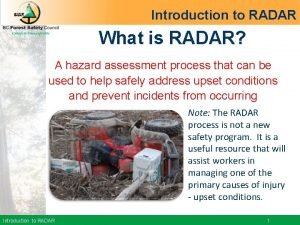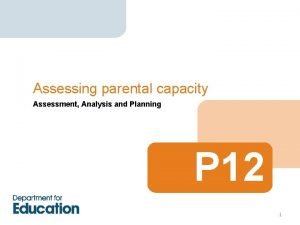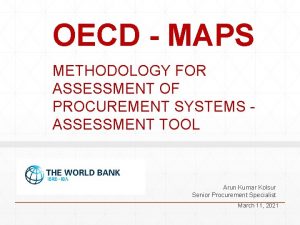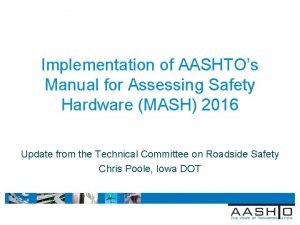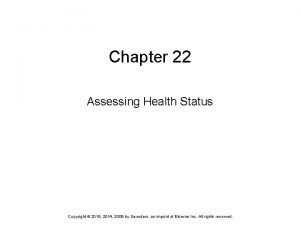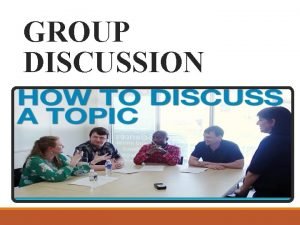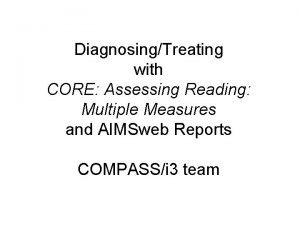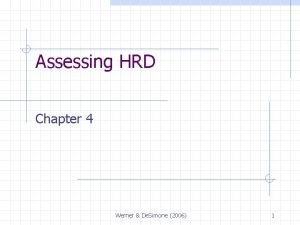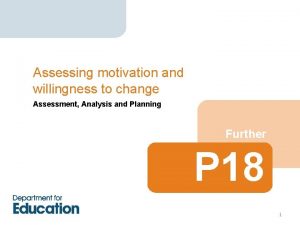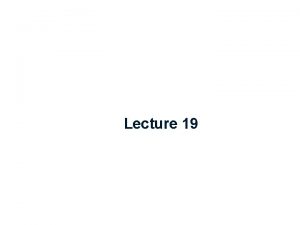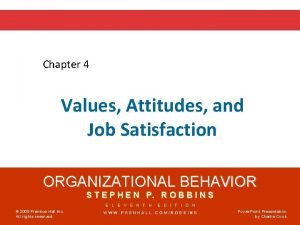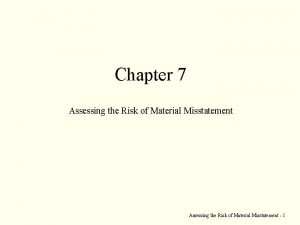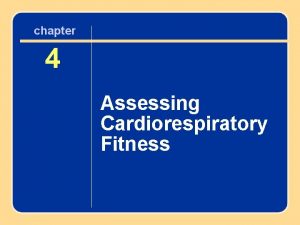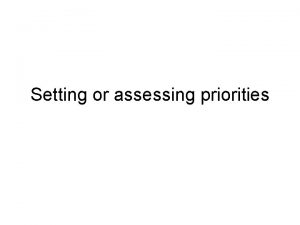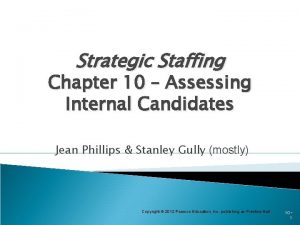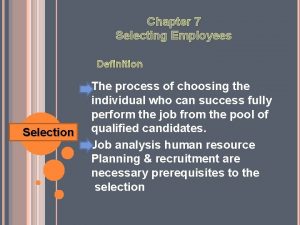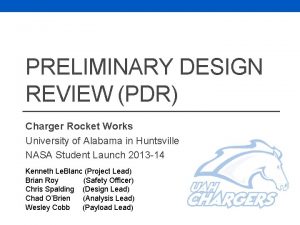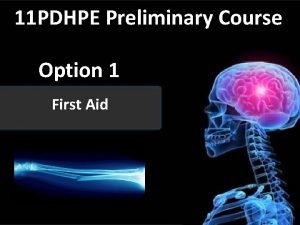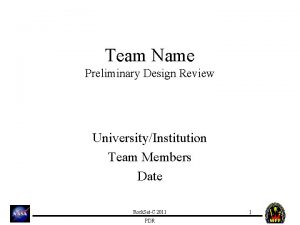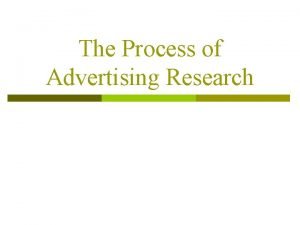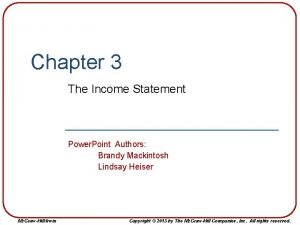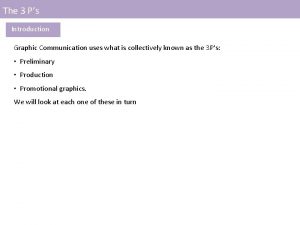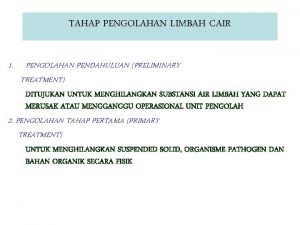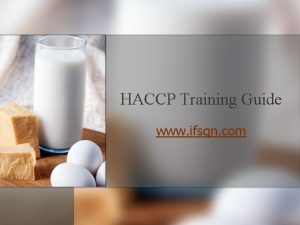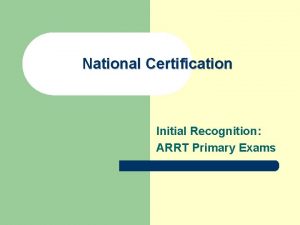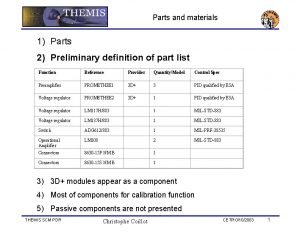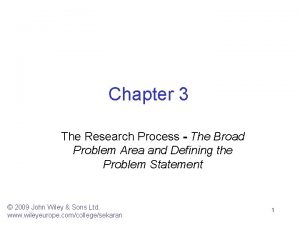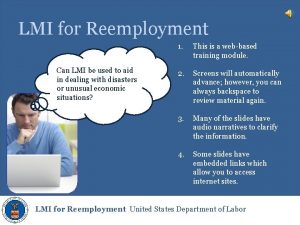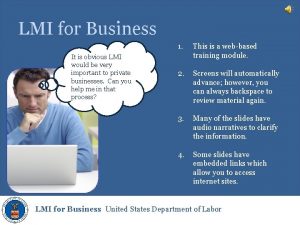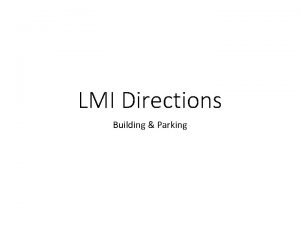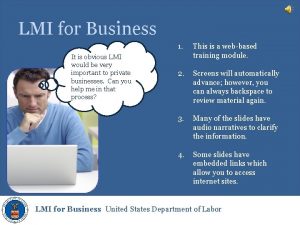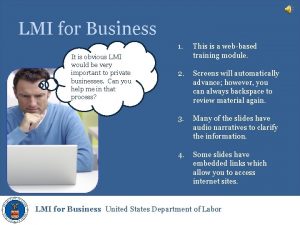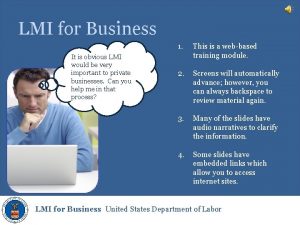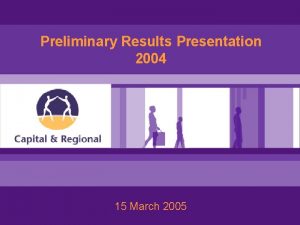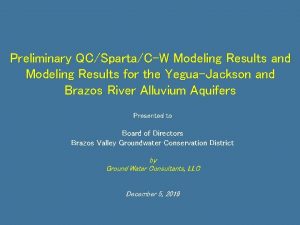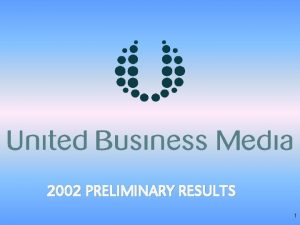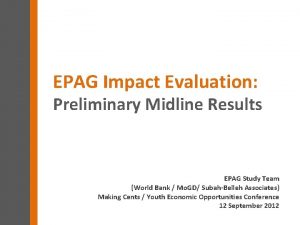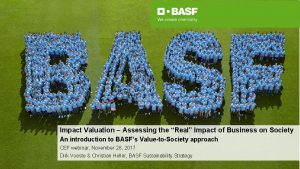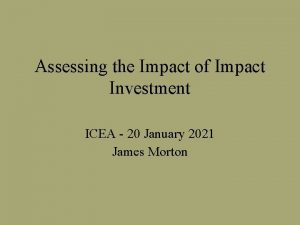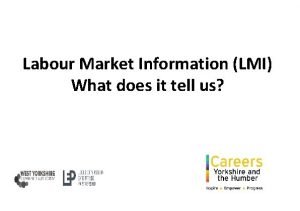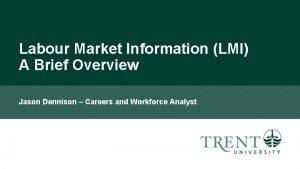ASSESSING THE IMPACT OF LMI PRELIMINARY RESULTS OF




















































- Slides: 52

ASSESSING THE IMPACT OF LMI: PRELIMINARY RESULTS OF PHASE TW Research Team Canadian Research Working Group in Evidence-Based Practice (CRWG), Canadian Career Development Foundation (CCDF) In partnership with New Brunswick Post-Secondary Education & Labour, Saskatchewan Advanced Education, Employment & Immigration 1

Overview • Provide background on the project • Share results • Hear the perspectives of the research partners • Consider next research steps 2

Our Research was an Important Step Forward • Most LMI research focuses on usability of products – Readability – Accuracy of information – Easy to access – Amount of use – Most research is with students; very little with adults • Several questions remain unanswered – How do people use LMI? – What prompts them to make an action plan + implement it? – What (if any) assistance would be helpful? 3

• There is very little literature about the direct contribution of LMI to employment/career decision-making • This research project directly addressed this question Savard & Michaud, The Impact of LMI on Career Decision-Making Process: Literature Review, FLMM, 2005 4

Research Questions • If client needs are assessed and clients are given LMI consistent with their needs, • • To what extent does assistance by a service provider enhance their effective use of LMI? OR • To what extent is independent self-help a sufficient process for clients to use LMI effectively? 5

Research Questions ¤ What type of assistance in finding and using LMI, provided to clients with jobsearch and decision-making needs, leads to what kinds of outcomes? ¤ How do clients process the LMI they access and how do clients use that information to create a plan for action? 6

Our Approach was Unique • We used real frontline counsellors with real “adult” clients in their customary settings – not counselling interns and students in an academic setting. • We based our experimental design process on the existing service delivery processes used by the participating agencies so the processes could be incorporated with little effort if research results proved positive. • We delivered interventions that isolated the effects of LMI on decision-making – separating it from other interventions such as career counselling or job search workshops that usually subsume LMI. 7

Method • We reviewed current practices to determine: – The current process for identifying client service needs – “Favourite” LMI resources – Access to the Resource Centre 8

Favourite LMI Resources • We prepared “guided” LMI packages – Career Decision Making: • Know yourself • Know the Labour Market • Put it all Together – Job Search: • • Check for “Fit” Get Ready Search for Work Get a Job 9

E M P L O Y A B I L I T Y D I M E N S I O N S CCDF, 2010 10

Checklist for Counsellor STEPS STEP 2: Gather Employability Information Gather data on job readiness issues (financial needs, personal needs, motivation, ability to keep a job) Gather employability information relevant to Career Decision Making o Client’s self-knowledge (abilities, interests, values, personal characteristics) o Client’s knowledge of career options o Client’s ability to research options o Client’s knowledge of local labour market opportunities o Client’s career vision/employment goal Gather employability information relevant to Job Search o Clarity of client’s employment goal o Client’s need for appropriate job search tools (resume, references, professional pitch) o Client’s ability to search for work (using networks, job interview skills) o Client’s ability to assess employment possibilities Verify client perspective Obtain agreement on identified needs Not done Sort of done Done 11

Another protocol to follow STEP 2: Provide information and advice by using some of the interventions listed below: (It is not expected that you will do all of these with every client, but we want to know what you did cover with each client. Check off as many as apply) 1 st AIS Did you: 1. help clients find a resource to link their interests and/or skills to job/career requirements 2. help clients link their interests and/or skills to job/career requirements 3. help clients find meaningful Labour Market Information 4. help clients interpret/understand Labour Market Information 5. help clients find any information that applies to their own career/job search (companies, employers, job fairs, job banks, openings/closings, industry information, job descriptions, wages, etc. ) 6. help clients interpret any information so that it meant something to their own career/job search 7. help clients find resources on job search methods (resume, interview skills, etc. ) 8. give clients advice on job search methods (resume, interview skills, etc. ) 9. help clients to find decision-making tools 10. help clients to use decision-making tools 12

Even the Client had a Checklist • From the list of LMI resources they had in their LMI package, they had to check which they used and how many times. Example: – Career Cruising – Job Bank – Job Futures • And give names of any other sources they used 13

Intervention All participants in the study: ¤ Received a needs assessment interview & completed an initial, pre-program survey ¤ Received an LMI package specific to their identified employability need ¤ Were randomly assigned to either a selfdirected intervention delivery method or an assisted self-directed intervention delivery method. ¤ Were given an orientation to the Resource Centre which they could freely use on their own ¤ Completed a post-pre survey ¤ Received a cash honorarium and certificate of participation 14

Intervention (cont) In addition, the assisted self-help clients received: ¤ Two additional AIS interviews (20 -30 minutes) focused on helping them understand, interpret and apply the LMI to their own situations and /or access additional LMI 15

Experimental Conditions • Intervention = a Career Decision-Making or a Job Search LMI Package • Delivery = Independent Self-directed Assisted Self-directed Resource Centre only plus independent research Resource Centre and independent research PLUS 2 follow-up Information and Advice Interviews with a counsellor • In two provinces: New Brunswick and Saskatchewan 16

Intervention Research Design Job Search Time 2: After CDM nt e nd I pe e nd Time 1: Before Delivery As d e t sis

Sample • 8 employment centres in two provinces, Saskatchewan and New Brunswick. • 169 participants began the study » 13 discontinued participation » 5 submitted incomplete data where one or more of the survey forms was missing • 151 provided complete data 18

Sample by Province Saskatchewan Intervention Type Delivery Total Independent Assisted CDM 20 15 35 JS 23 25 48 Province Total 43 40 83 CDM 28 15 43 12 13 25 40 28 68 New Brunswick JS Province total Total for 2 provinces 151 There were no differences in pretest scores between provinces • Therefore we combined provinces for data analysis • This Increased the cell size + therefore increased the statistical power 19

Sample Continued ¤ 74 males and 77 females ¤ Age: 19 - 62 years (Mean age = 44 years) ¤ 149 were Canadian citizens or landed immigrants (legally entitled to work in Canada) ¤ 118 had not previously participated in employment services programs ¤ 35 were working full or part-time ¤ 6 said their work was a good fit for them ¤ 115 participants were not employed 20

Employment History • In the past 5 years • 30 of them had been in 5 or more jobs • 22 had been in 4 jobs • 25 had been in 3 jobs • 46 had been in 2 jobs • 24 had been in the same job for the past 5 years 21

Unemployment History • In the past 5 years • 15 had been unemployed for 36 -60 months • 15 had been unemployed for 18 -30 months • 15 had been unemployed for 12 -16 months • 19 had been unemployed for 6 -11 months • 26 had been unemployed for 1 -5 months • 42 had not been unemployed over the past 5 years 22

Approach to Evaluation Outcome-Focused, Evidence-Based Practice Input Process Outcome Framework developed by CWRG 23

Outcome-Focused Evidence-Based Practice Input Process Outcome Indicators of client change 1. Learning outcomes • Knowledge and skills about using LMI 2. Personal attribute outcomes • Changes in attitudes, confidence, optimism, etc. 3. Impact outcomes • employment status 24

Outcome-Focused Evidence-Based Practice Input Process Outcome Activities that link to outputs or outcomes 1. Tailored LMI Packages 2. Protocol for assisted self-help 3. Counsellor check lists 4. Client checklists 25

Outcome-Focused Evidence-Based Practice Input 1. 2. 3. 4. Process Outcome Resources available Staff time Resource Centres Self-selected on-line resources Needs determination protocol 26

What Did We Measure? The Dependent Measures for the data analysis were: • General ability to use LMI • Knowledge » Clear vision of what I want in my career future » Knowledge of print and online resources • Skill » Have effective strategies for keeping myself motivated » Have a realistic action plan • Personal Attributes • Optimism about what lies ahead re meeting my career goals • Confidence in my ability to manage future career transitions 27

How Did We Measure? Problems with standard Pre-Post Design • Pre: Before they experience a program, participants are asked to rate their skill (or knowledge) – Often, pre-program scores are higher because people don’t know what they don’t know • Post: After experiencing a program, participants are also asked to rate their skill – Often post-program scores are lower because people have found out that they knew less than they thought or had less skill than they thought • So, a comparison of difference in scores may not reflect the true difference. 28

How can we get around this problem? Use a Post-Pre Assessment AFTER the program At the end of the intervention, we asked the participants to compare themselves now and before the intervention: “Knowing what you know now, how would you rate yourself before the research session, and how would you rate yourself now? ” 29

Descriptive Results • Looking at the 14 items in the survey instrument: – Before the intervention: between 30% and 58% of the respondents indicated that their level of competence on that item was “Not OK”; – After the intervention: 1% – 9% indicated that their level of competence on that item was “Not OK”. • Mean Scores: – Before the intervention: All responses (1 exception) were in the “Not OK” range; – After the intervention: All responses were greater than minimally OK (mean score 3 or greater) (2 exceptions where the mean scores were 2. 19 and 2. 96) 30

Descriptive Results (cont) • Before the intervention: 45% (n=946) of responses were “not OK” (0 or 1); • After the intervention: 5% (n=95) of the responses were “not OK”. 31

Descriptive Results (cont) • Before the intervention: 5% (n=108) of the responses were “Exceptional” (4); • After the intervention: 39% (n=825) of the responses were “Exceptional”. • The amount of change was similar across all three dimensions of the survey: knowledge, skills, and personal attributes. • All 3 dimensions demonstrated about the same amount of change. 32

Descriptive Results (cont) • Of particular note are items that suggest increased ability to self-manage their careers, such as: – A clear understanding of what I need to do to move forward in my career. – A clear vision of what I want in my career future. – Knowledge of print and online resources that help me to research career/employment options. 33

Descriptive Results (cont) • More items that suggest increased ability to selfmanage their careers: – The ability to access career resources that can help me implement my career vision. – Effective strategies for keeping myself motivated to achieve my career/employment goals. – A realistic action plan (or schedule) summarizing the main career/employment-related activities I want to pursue and the processes I am engaging in. – Confidence in your ability to manage future career transitions. – Confidence in my ability to research career, employment, and training options that are available 34

Overall Ability to Use LMI For group as a whole: • significant increase in skills for using LMI • neither intervention was more conducive to one manner of delivery compared to the other • Both CDM and JS groups had significant increases across time • Change in CDM group was significantly larger than in JS group • Participants in the JS group had higher scores than participants in the CDM group, likely indicating that JS participants were more familiar with using LMI before the project began. • Participants receiving assistance demonstrated greater change in skill at using LMI than did those in the independent mode 35

Knowledge on How to Use LMI For group as a whole: • significant increase in knowledge about how to use LMI • neither intervention was more conducive to one manner of delivery compared to the other • Both CDM and JS groups had significant increases across time • Change in CDM group was significantly larger than in JS group • Participants in the JS group had higher scores than participants in the CDM group, likely indicating that JS participants were more familiar with using LMI before the project began. • No difference in knowledge gain between those receiving assistance and those in the independent mode (p =. 09) 36

Skills in Using LMI For group as a whole: • significant increase in skills for using LMI • neither intervention was more conducive to one manner of delivery compared to the other • Both CDM and JS groups had significant increases across time • Change in CDM group was significantly larger than in JS group • Participants in the JS group had higher scores than participants in the CDM group, likely indicating that JS participants were more familiar with using LMI before the project began. • Participants receiving assistance demonstrated greater change in skill at using LMI than did those in the independent mode 37

Personal Attributes Related to using LMI For group as a whole: • significant increase in personal attributes related to using LMI • neither intervention was more conducive to one manner of delivery compared to the other • Both CDM and JS groups had significant increases across time • Change in CDM group was significantly larger than in JS group • Participants in the JS group had higher scores than participants in the CDM group, but the gap was less at the end of the study (i. e. , CDM group reported greater change). • Participants receiving assistance reported higher scores than did those in the independent mode 38

Sample of learning outcomes Regarding the Primary Objectives, and knowing what you know now, how would you rate yourself before the workshop, and how would you rate yourself now? Before After Ave 1. A clear understanding of what I need to do to move forward in my career. 21 57 48 16 1. 57 1 3 28 66 53 3. 11 2. A clear vision of what I want in my career future. 24 37 40 39 11 1. 84 1 7 29 63 51 3. 03 3. Reviewed my past work, education and experience so that I know what skills and strengths I have. 11 33 57 35 14 2. 05 2 3 21 68 56 3. 15 4. A list of possible options that may fit with what I want in my career future. 23 49 47 23 9 1. 64 1 4 25 66 54 3. 12 5. Knowledge of print and online resources that help me to research career/employment options. 32 55 42 16 5 1. 38 1 1 21 53 74 3. 32 6. Confidence that career-related employment opportunities actually exist that fit with what I want in my career future. 19 41 58 25 8 1. 75 1 10 27 58 55 3. 03 • • • 9 On these 6 items (K = 1, 2, 3, 5; S = 4; PA = 6) Pre: 402 Unacceptable Ratings – Post: 35 Unacceptable Ratings decreased from 45% to 4% Pre: 56 Exceptional Ratings – Post: 343 Exceptional Ratings increased from 6% to 38% of the participants Pre: 80% of means were Not OK – Post: all means were more than min OK 39

Attribution for Change To what extent would you say that any changes in the ratings on the previous pages are a result of your participation in this research project, and to what extent were they a function of other factors in your life? mostly other factors somewhat other factors uncertain somewhat this program mostly this program CDMIndependent 0 2 5 14 26 CDM-Assisted 0 1 1 8 20 JS-Independent 3 0 6 14 12 JS-Assisted 0 0 3 11 22 Total 3 3 15 47 80 Program 40

Attribution for Change • To what extent would you say that any changes in the ratings for the before and after survey questions are a result of your participation in this research project, and to what extent were they a function of other factors in your life? Of 148 respondents: – 47 said “somewhat this program” – 80 said “mostly this program” 41

Impact Outcomes-1 Employment status If you answered yes to the above question, to what extent does this work fit with your career vision? 42

Impact Outcomes-2 Action plan 43

Impact Outcomes-3 Desire help in creating an action plan 44

Other Noteworthy Results • No significant gender differences – Women and men responded equally well to all intervention-delivery combinations • Other analyses in progress – – Work history Unemployment history Age Post-intervention interviews with selected clients (n=64) 1 week and 4 months post the study 45

Other Noteworthy Results (cont) • We also are analyzing the process data – The process checklists will provide evidence that the counsellors followed the game plan and that the clients were engaged with the LMI material – This will permit us to say that the program (Intervention + Delivery) is responsible for the change 46

LMI: General Summary of Results ¤ All intervention-delivery combinations produced significant change in: • • General ability to access and use LMI Knowledge about how to use LMI Skills for using LMI and taking action Personal attributes, e. g. , optimism, confidence, and by inference, motivation ¤ Assisted use produced greater change across time than independent use ¤ Over 80% of clients attribute change to the program and not other factors 47

What have we learned? Perspectives of the Research Partners 48

What have we learned? (for clients in this study) • “Guided” LMI, (i. e. , LMI embedded in a learning process) results in knowledge and skill acquisition as well as the capacity for self-management • LMI appropriate for a client’s specific need (opposed to general LMI) appears to support engagement and action • A little professional support can go a long way for many clients! • Structure, a roadmap, and timelines appear to motivate action and a sense of progress • Giving clients hands-on tools appears to motivate more than money! 49

What helped make the project work • • • The leadership of the provinces was exceptionally strong The service providers caught the spirit of the research and went with it, even though it was not an exact fit for them The front-end screening (service needs interview) was well done, and permitted a strong match between client need and intervention focus The tailored intervention packages were superb The attention to detail in data collection was very well done 50

What needs to be done next? A Sample… • This research was in English only; French to come (hopefully!) • There are 5 employability dimensions; only 2 have “guided” LMI • We do not know what the impact of “guided” LMI within an employment counselling process would be; nor do we know the impact of “guided” LMI packages self-selected by clients (no assessment) – these could be hugely informative for service delivery 51

Thank you Research Partners, and Thank you for your attention today!
 Preliminary results example
Preliminary results example Lmi humber
Lmi humber Frame relay lmi
Frame relay lmi Santanu dasgupta cisco
Santanu dasgupta cisco Lmi único empresarial
Lmi único empresarial Lmi lucht
Lmi lucht Moc crosswalk lmi
Moc crosswalk lmi Lmi skale
Lmi skale Cultural dynamics in assessing global markets
Cultural dynamics in assessing global markets Strengths and weaknesses assessment
Strengths and weaknesses assessment Amc math assessment
Amc math assessment Assessing leadership and measuring its effects
Assessing leadership and measuring its effects Hazard communication quiz answers
Hazard communication quiz answers Assessing grammar effectively
Assessing grammar effectively Parental capacity example
Parental capacity example Methodology for assessing procurement systems
Methodology for assessing procurement systems Cultural dynamics in assessing global markets
Cultural dynamics in assessing global markets Manual for assessing safety hardware
Manual for assessing safety hardware Assessing the internal environment of the firm
Assessing the internal environment of the firm Assessing health status chapter 22
Assessing health status chapter 22 Module 4 topic 1 assessing and managing risk
Module 4 topic 1 assessing and managing risk Ncbts and ppst comparison
Ncbts and ppst comparison Group discussion is a modern method of assessing
Group discussion is a modern method of assessing Core multiple measures
Core multiple measures Assessing a new venture's financial strength and viability
Assessing a new venture's financial strength and viability Assessing hrd needs
Assessing hrd needs Assessing risk in sport regulatory bodies
Assessing risk in sport regulatory bodies Cultural dynamics in assessing global markets
Cultural dynamics in assessing global markets Assessing motivation to change
Assessing motivation to change Module 4 topic 1 assessing and managing risk
Module 4 topic 1 assessing and managing risk Assessing need for hrd
Assessing need for hrd Values attitudes and job satisfaction
Values attitudes and job satisfaction While assessing the risks of material misstatement
While assessing the risks of material misstatement Assessing cardiorespiratory fitness
Assessing cardiorespiratory fitness Assessing opportunity cost involves
Assessing opportunity cost involves Unit 18 assessing children's development support needs
Unit 18 assessing children's development support needs Assessing value for money
Assessing value for money A nine box matrix requires assessing employees on ________.
A nine box matrix requires assessing employees on ________. Preliminary interview
Preliminary interview Preliminary assessment
Preliminary assessment Preliminary design review example
Preliminary design review example Year 11 pdhpe first aid
Year 11 pdhpe first aid Preliminary design review example
Preliminary design review example Advertising research process
Advertising research process Determine junktrader’s preliminary net income.
Determine junktrader’s preliminary net income. Preliminary graphics
Preliminary graphics Reading part 6 pet 2020 pdf
Reading part 6 pet 2020 pdf Preliminary treatment adalah
Preliminary treatment adalah Preliminary steps of haccp
Preliminary steps of haccp Waterfall strategy
Waterfall strategy Pearson vue arrt
Pearson vue arrt Preliminary material
Preliminary material Broad problem statement example
Broad problem statement example
